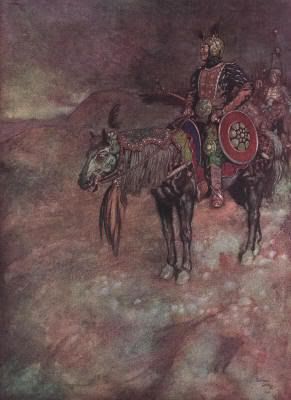 "Tamerlane" by Edmund Dulac, "The Bells and Other Poems" by Edgar Allan Poe, 1912
"Tamerlane" by Edmund Dulac, "The Bells and Other Poems" by Edgar Allan Poe, 1912In a previous article about the Timur Bekmambetov film "Night Watch" I made a comparison between the allegory of a war between Light and Dark occult forces and the allegorical visual techniques of the Baroque art movement, specifically the work of Rembrandt Van Rijn, due to his famous group portrait popularly called "Night Watch". There is no major painting that I know of titled "Day Watch" (though some commentators jokingly rechristened Rembrandt's painting as such when restoration revealed the image's gloomy atmosphere was due to varnish and dirt rather then a nocturnal setting). But the great Edmund Dulac's illustration of Tamerlane brings us to equally interesting places, I believe, the Romantic tradition and its continuous influence on popular entertainment. As a product of the Golden Age of Illustration, Dulac's work serves beautifully as an example of a pivotal, stepping stone movement of High Fantasy storytelling.
Rembrandt's "Night Watch" was first called such by English Royal Academy President Sir Joshua Reynolds, a Mannerist whose promotion of Classical formatting inspired the Romantic reaction of the Pre-Raphaelites. The Pre-Raphaelites inspired the Symbolists, the Arts and Crafts Movement, and Art Nouveau. This aesthetic certainly informed the glorious, narrative visuals of the Golden Age of Illustration. In turn we can see the influence the Golden Age had in the early 20th Century on Pulp Magazine illustrations and newspaper comic strips, with no better example then the lavish work of Winsor McCay, important visual precedents for the modern, commercial storytelling mediums of comic books, animation and films. Dulac in this instance is illustrating Edgar Allan Poe's poetic treatment of the story of "Tamerlane", Timur the Lame, Poe's first published work, and a name he sometimes utilized to denote himself (and interesting enough also the namesake of the director of the Watch films, Timur Bekmambetov). All of which fits neatly in this Romantic fold. Like the Pre-Raphaelite/Symbolist movement and its offspring, the Watch books and films are about a tradition of Magic (Art), with an emphasis on Medievalism both European and Asian.
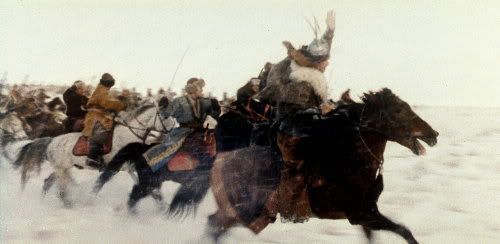
"Day Watch" opens with a stunning presentation of the legendary historical figure of Tamerlane leading his warriors in a search for the Chalk of Fate, a device allowing a user to rewrite Fate, to correct their past regrets.
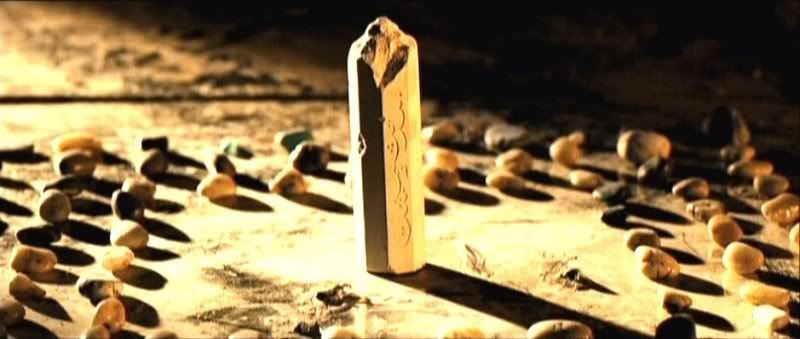
As we watch Tamerlane smash his way through stone walls on horseback we see that the Great Tamerlane is a powerful Other. The Chalk, kept in a Labyrinth fortress, is in turn protected by Others, including Crows who drop from the sky and shape shift into black armored warriors.

It is plainly stated that possessing the Chalk is the means to the many conquests of Tamerlane, who from that point forward could always correct his mistakes, rewriting time and reality itself. From the very start "Day Watch" makes an overt metaphorical comparison between acts of magic and the process of creating art, and does so with an item that is the most essential of mark makers, the rubbing of one stone onto another. It is the Philosopher's Stone as item of most basic media, in the form of a six or eight sided column, kept in a perfectly square fortress, a detail emphasized by the Chalk's placement within three concentric squares of stones. You could say the Chalk of Fate lies Inside the Cosmic Cube. We might note also that the Persian setting of the Tamerlane story reminds us of the Zoroastrian dualistic connotations of the Light versus Dark pattern integral to the Watch movies' symbolism.
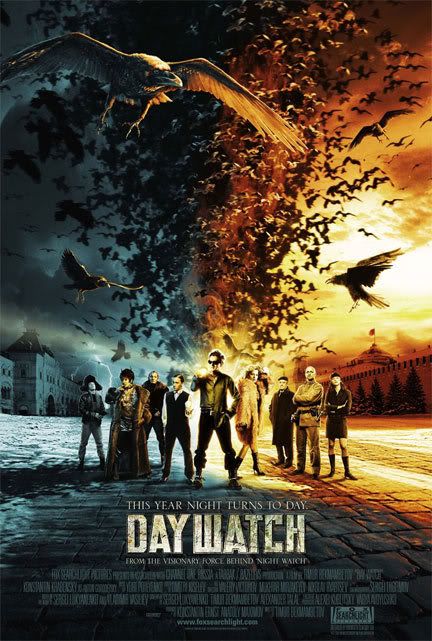
The dichotomy symbolism is readily apparent in this promotional poster, Dark and Light Others in balance, with Anton at the center, Night and Day, Silver and Gold, the Moon and the Sun. There is a lot of promotional art for this film, and most of it is really interesting. I'm particularly taken with this image of Yegor, based on M.C. Escher's 1955 wood engraving "Rind".

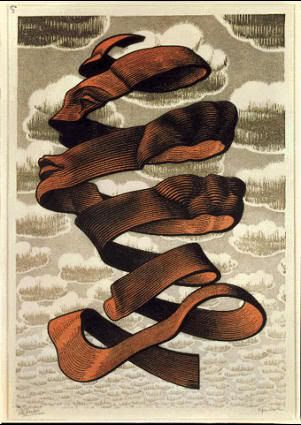
With the two-sided strip utilized as a tidy means to refer to the Crow/Warrior symbolism used throughout both films. In Russia there was a series of promotional pieces featuring the major characters and the title, "Dnevnoi Dozor", with an interesting use of Da Vinci's "Vitruvian Man" worked into the design.

Further, I think it's pretty clear that we're seeing the characters' auras in these shots, a device not featured in the films, but utilized beautifully throughout the novels. And, despite the fact that I missed it the first go-around, here's a poster for "Night Watch/Nochnoi Dozor" featuring Zavulon and Gesser (and Olga) facing off across a chess board pattern.
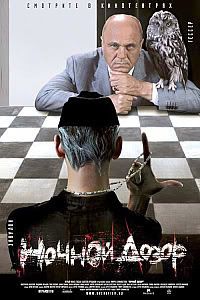
So I was pretty good about not spoiling "Night Watch", right? But I don't think that's going to be the case here with "Day Watch". This is only appropriate as this half is dedicated to the bad guys, it is only proper then to be a little evil. The Watch films are both actually based on events depicted in the first book in the Sergey Lukyanenko series, "Night Watch", and there are some major structural changes in the adaptation, such as making Yegor Anton's son. Lukyanenko worked on the scripts, approving and contributing to the reinterpretations. He then artfully made use of the alternate version of his universe in book four of his series, "Final Watch", wherein several details from the films are referred to as dreams the characters had, such as Yegor dreaming Anton was his father. Anton replies that dreams can be visions of alternate realities.
In the commentary track for "Day Watch" director Timur Bekmambetov makes vocal reference more then once between the comparability between film making and witch craft. At one point he states that he utilized film language to create a magical world, that film language is itself a kind of magic, and making a film then a magic spell, creating an illusion out of what is really just shadows on a screen set to a soundtrack, presented to people who sit in a dark room and share a dream. As you might imagine, I found this to be a delightful description given the arguments I present in my "Legerdemain" series.
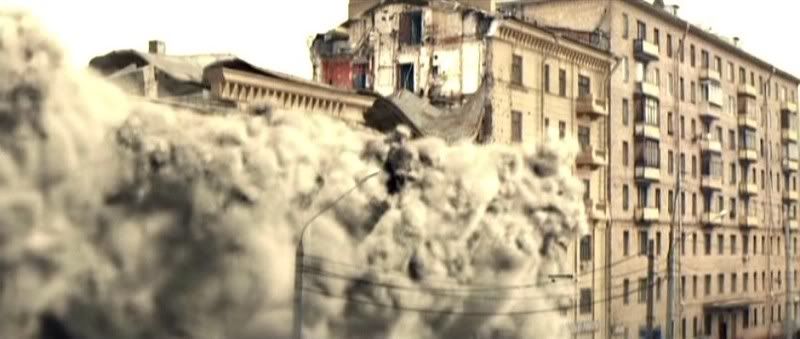
Tamerlane's obtainment of the Chalk of Fate is immediately followed by footage of an apartment building in modern day Moscow undergoing demolition. It is the location of the witch Darya Schultz from the beginning of "Night Watch", but a wall is left standing, the one featuring the witch's collage. This is important, the emphasis of this story element that symbolically signifies art and magic as one and the same. While not really comprehensible to Western audiences, the movie utilizes the designs of famous Russian corporate logos, reflected in the windshield of a Night Watch truck, as the opening credits. The logo as art magic generated to affect or manipulate its viewers for a purpose (specified and sometimes unspecified) is easy to conceptualize. Riding in the truck are Anton and his new trainee Svetlana. Anton, initiated to the world of the Others in "Night Watch" is now himself an initiator. They receive notification of a Dark Other attack on a normal human and report to the scene.
Svetlana, full of rookie enthusiasm to fight the forces of Darkness, naive still to the necessities of the Watches' delicate balance, spots the culprit, a teenage boy in full ski Mask (a Veil), and engages a pursuit into the Gloom despite Anton's admonitions not to. Anton goes after. The great power possessed by both the boy and Svetlana is demonstrated as he enters into the second level of the Gloom, and she follows, an act the more experienced Anton has never performed.
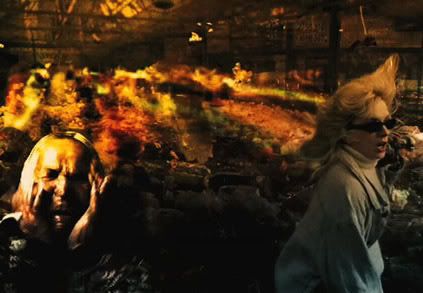
The alien nature of this level is presented through time-lapsed images of fast-motioned pedestrians, teeming and moving about erratically, and as we see in this still in obvious discomfort, as if the Gloom is Hell (they are perhaps Others who have become trapped in the dangerous second level of the Gloom). Furthering this connotation is the dismal, decrepit state, the Gloom is littered with garbage and loose papers, keeping the negative presentations of this Otherworld thoroughly contemporary.

Anton lacks the power to follow into the second level, here depicted separated by a pane of glass. He calls Svetlana back, but when her back is turned the young Dark Other pierces Svetlana with one of the needles he uses to feed off others from a distance, drinking their life-force. This feeding is depicted throughout the movie as occurring from a distance, the Dark Other sips from a juicebox, labeled "Zloy" (Evil) a parody of a Russian juice brand called "Dobryi" (Good). This is an intriguing manner to combine the symbolism of vampirism with a common child activity, thoroughly innocent in almost any other circumstance.
The Dark Other pierces Svetlana with his needle, and she turns and pulls off his mask. The boy is Yegor, Anton's son, who at the end of "Night Watch" chose to follow the path of the Dark Others. Mirroring Sveta's enthusiasm, new initiate Yegor is eager to engage in Dark activity. Svetlana directs her weapon, a flashlight/torch, such as Anton used in "Night Watch", again, a clear symbol of Illumination/Enlightenment.
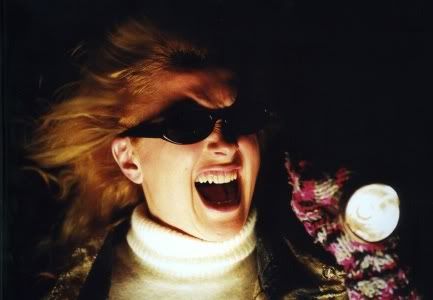
Panicked that the Light will hurt his son, and by the conflict in general, Anton manages to force his hand through the glass separating the first and second level, and pulls Sveta out into the normal level of existence. Yegor gets away, but Sveta has his Mask, physical evidence for the Night Watch investigation of the crime.
We then see Zavulon and Alisa tangoing in a hall Zavulon has rented at the aptly named Hotel Cosmos. The hall is decorated with photos of rockets from the Soviet/Russian space program, and a prominent golden Saturn on the wall. Even the tango has symbolic significance, as a coordinated dance designed to appear improvisational, an activity representing both sex and conflict.
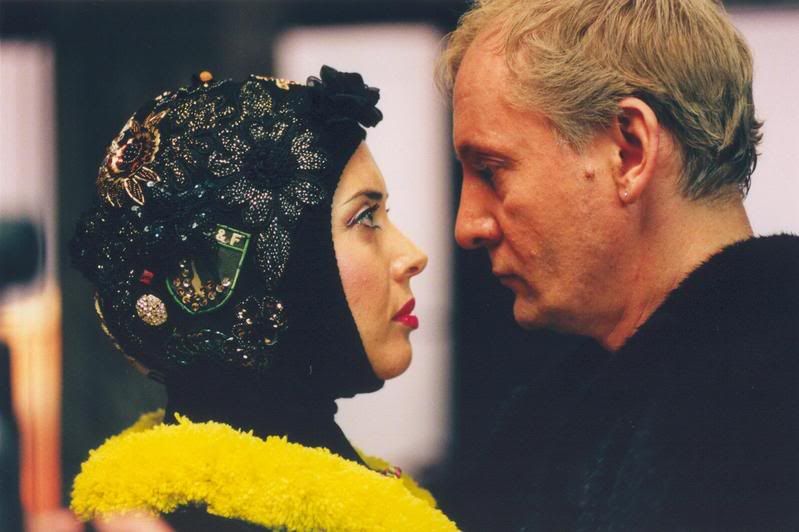
Alisa, who was somewhat peripheral in "Night Watch", becomes a key player in the sequel, where we learn she is bound to Day Watch head Zavulon through a Gold Ring that lets him feel what she feels, a ring we later learn causes her pain which she can't remove, obviously a curse. With Alisa we see regret at a Faustian deal in the form of a marriage. Even more so a Plutonian relationship, the False Flowers (black and gold and bejeweled, the flowers of Hades) decorating Alisa when first introduced in this film suggest the Persephone model, the Maiden taken into the Underworld and made its Queen. This is appropriate for a character named Alice whom we always must remember started her adventures with a Fall into the Underground, and via a game of chess became a Queen.
Later that night, Anton is approached by Galina Rogova, Yegor's Dark Other tutor. Galina reminds Anton that Yegor's birthday is tomorrow, and suggests Anton get him a ski mask, the implication being that Anton should retrieve the evidence of Yegor's crime from the Night Watch in order to save him from prosecution by the Inquisition. Anton refuses and even wishes death upon her and Galina drives off. This exchange is witnessed by Kostya, Anton's vampire neighbor.
Despite refusing to help Yegor, Anton then goes to the Night Watch headquarters, breaks into the archives and steals Yegor's mask. While he is doing so, Galina is stalked and murdered at her own apartment building, stabbed with a wooden dagger that leaves no physical wounds. Her body is left lying in a stairwell with a checkerboard floor.
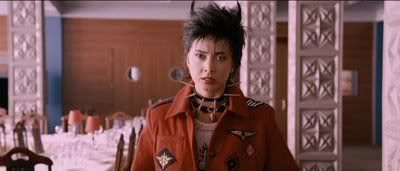
When Alisa informs Zavulon of Galina's murder he immediately blames Anton, and sends Alisa to find evidence of this. The viewer knows Anton is innocent of course, but he has no viable alibi, as during the time of the murder he was engaged in stealing Yegor's mask from the Night Watch archives. Alisa's Goth devil get up is fully appropriate for her Persephone role. Also note the Tetramorph star pattern on the columns of the Cosmos Hotel ballroom. In the course of her investigation of Anton, Alisa speaks with Kostya, Anton's vampire neighbor, interrupting a soccer/football game he's playing in to do so. This not only connotes the relative youth and innocence of Kostya, but incorporates the black/white pattern as sphere of a soccer ball. There is immediate chemistry between Alisa and Kostya.
Gesser and Olga are fully aware and unconcerned about Anton's theft of evidence, but it does present the problem of Anton having no viable alibi against the murder charge, a crime the Day Watch has obviously set him up for. To protect Anton, Gesser switches Anton and Olga's bodies. As he engages in this act of magic two crows are depicted flying upwards, confirming the film's utilization of Birds as symbolic of human consciousness or the soul. Gesser suggests Anton (as Olga) stay with Svetlana. He retrieves Svetlana from a Night Watch class (the Night Watch in part being an Invisible College or Mystery School). In the commentaries we learn that Sveltlana's classmates are all Russian science fiction and fantasy authors. The class is learning to detect objects and individuals hidden from view. The instructor asks Svetlana to detect who is at the door. Svetlana answers "Anton", but it seems like she is wrong because Anton is in Olga's body.
The gender swap that occurs between Anton and Olga for a period of time in this film incorporates the major occult symbolism of hermaphrodism. The predominant theme of the Watch movies is the conflict between Light and Dark, the balance between the two representing fundamental order. Underlying this, the veiled theme, is the conceptualization of crafting fiction as act of magic as discussed. In this light it could be said that the Anton/Olga shift then speaks of this symbolic motif in fiction itself, the hiding of a archetypal character or figure of one gender through the guise of the other (i.e. the male Spider-Man symbolizing the female Ariadne as discussed in Tingly Intuition).
The device of a gender switch further connotes a process of personal or spiritual development. As Anton is the protagonist and focus, we can view his transferral into a female body as his continued evolution, connection with the feminine principle, a further level of initiation (naturally enacted by Gesser). In this light it is interesting that, due to Svetlana believing him to be Olga, he realizes that she loves him. Anton is described as having been celibate for twelve (a full cycle) years. Anton in turn professes his love for Svetlana. Sveta is at first embarrassed and angry when he confesses that he is actually Anton, but they are soon making love in her shower, an act presented as a transport as the waterfall wall decoration becomes a real location.
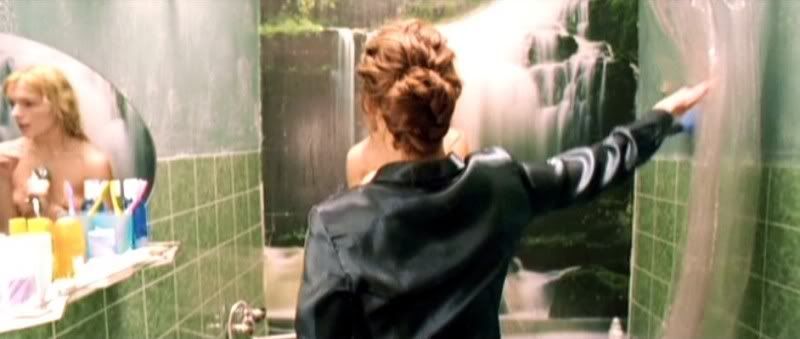
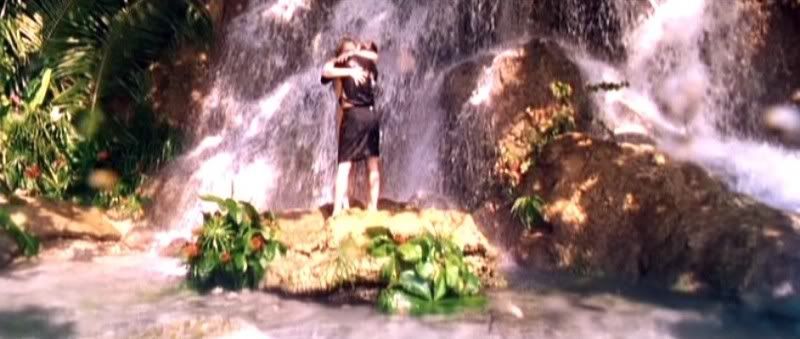
As was the case for the very famous, similar scene involving Demi Moore, Patrick Swayze and Whoopi Goldberg in "Ghost", we primarily see Anton's male form in this scene despite the fact that we know he's still inhabiting Olga's body. It is a humorous touch that we see him wearing Olga's skirt and heels through this scene, which in itself reasserts the hermaphrodite imagery. Balancing this scene, Alisa and vampire Kostya begin their dangerous affair, shown having sex while she drives her sports car full speed through Moscow, and doing donuts in the middle of the street. Whereas the union of Light Others is shown as a transport to Eden, that of the Dark Others is reckless, the thrill of flirting with disaster. Alisa becomes frightened and stops, as Zavulon can feel what she feels through the cursed ring.
Anton (still as Olga) and Svetlana go out for dinner. At the restaurant, they detect a Dark Other, having dinner with his normal family. Shortly after Anton discovers the Dark Other's corpse in the restroom, murdered as Galina Rogova had been. This time the set-up, despite Anton's hiding in Olga's body, places him at the scene of the crime. Dispelling the possibility that the use of an initiatory checkerboard floor at the scene of Galina's murder was accidental is its use again here at the second murder. Anton and Svetlana flee the scene, and are picked up by Gesser and Semyon in a Night Watch truck. They do not get far, however, as they are halted by Zavulon and a group of Day Watch agents. Zavulon demands Anton's arrest. Svetlana becomes enraged. Despite Gessers command not to break the truce, she shouts "Line 22" (11+11), causing a bus to manifest and smash directly into Zavulon. Zavulon is unmoved, he doesn't even fall over, but he is bloodied. His scream reverberates through the city, and he takes up a downed power line, using it as a massive whip. Anton/Olga flees the scene, managing to escape by jumping into a checker cab.
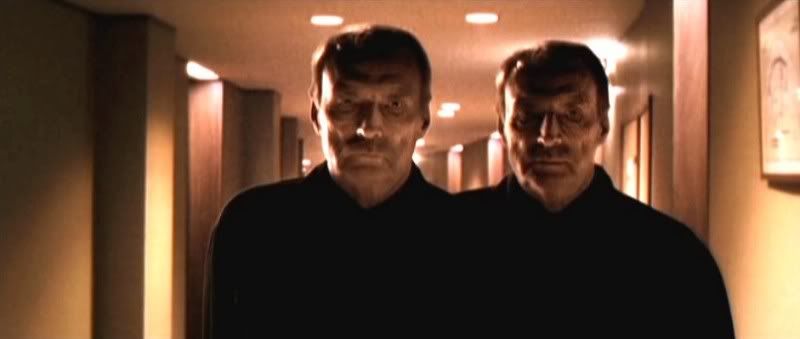
At the Night Watch headquarters Gesser is visited by agents of the Truce preserving Inquisition, depicted as twins, another major mythological and esoteric motif, and fully appropriate for the dualistic patterns of the story. Now that his cover is blown, Anton calls Olga and has her meet him at the airport so they can switch back to their own bodies. Anton has decided to try to fix all his problems by opening Tamerlane's tomb and retrieving the Chalk of Fate. He contacts the Night Watch located in Samarkand, where the tomb is located. Corruption even amongst Light Others is suggested as the the Samarkand Night Watch agent Anton speaks to then informs Zavulon of Anton's location. Alisa wants to personally pursue Anton but Zavulon instead decides to send "the Parrot". Zavulon's macaw transforms into a Day Watch agent, mirroring Olga and her Owl form in the first film, opposite in every way, male and female, solar and lunar, brash and wise.
Anton and Olga switch bodies at the airport and she insists on accompanying him on the flight to Samarkand. Olga tells Anton that the Chalk is not in Tamerlane's tomb, and that she knows this because she looked for it there herself. She also warns Anton that opening the tomb will start a terrible war. Olga explains she needed the Chalk to help a friend (Gesser). An elderly Other named Zoar warned her opening Tamerlane's tomb would start a war. She did so anyway only to find the Chalk wasn't there. This is based on a true Russian historical event. A flashback to Olga's excavation utilizes documentary footage of a Soviet dig at Tamerlane's tomb in the summer of 1941, with the actress playing Olga digitally inserted. According to modern folklore, the archaeologists were warned by local villagers that opening the tomb of Tamerlane, a great warrior, would release his spirit and war would break out. Shortly after the Soviet Union was attacked by Germany and entered World War II. The implied but unspoken implication here is that Olga's punishment, imprisonment in Owl form, was for causing World War II. Note that Athena/Minerva is not just a goddess of wisdom, but of war as well.
Anton realizes that Zoar is the owner of a Moscow pub frequented by Night Watch agents. He tells Olga to turn the plane around, apparently an action easy for a sorceress of her ability to perform. All of this is observed by the Parrot a few rows up in the cabin, who is spying on Anton and Olga by watching their reflections on the back of a spoon.
Back in Moscow Anton goes to Zoar and asks for the Chalk. Zoar has the Chalk in the pub, using it to write the daily specials on a black board, the most powerful object in the world, hidden in plain sight as the most mundane of objects. Anton takes the Chalk and writes "Yegor" on the board. Instantly Yegor shows up at Zoar's pub, stating he just happened to be passing by. The reunion is brief. Yegor asks Anton to come eat with him and his mother. Anton says that wouldn't be possible. Yegor runs off in anger. Anton is confused that the Chalk didn't work. Zoar tells him you can only change your own fate, not someone else's, and he must use it where his "destiny was broken". It is then Anton realizes that Yegor has stolen the Chalk of Fate.
Anton now must find Yegor to regain the Chalk and keep it out of the hands of the Dark Others. As he moves through Moscow he's pursued by the Parrot and a veritable army of Day Watch agents, who have been ordered by Zavulon to keep Anton alive but running. At one point Anton dodges his chasers by jumping into a advertisement poster, emerging from another in a subway station. The poster Anton exits through is that of a contemporary Russian film, according to Bekmambetov, used as a joke on the competition. The symbolic device of a movie poster as a magical portal is self-evident. Despite his teleportation to the Underground, the Dark Other army is still close behind Anton, but he dodges them by jumping onto a passing train moving at full speed.
The apparently omniscient Gesser realizes Yegor has the Chalk, and sees that the balance of the Light and Dark is now at a precarious point. Svetlana, more concerned about Anton then the status of the Truce, runs off alone, and is picked up by a checker cab (apparently one driven by the same driver as the cab earlier in the film).
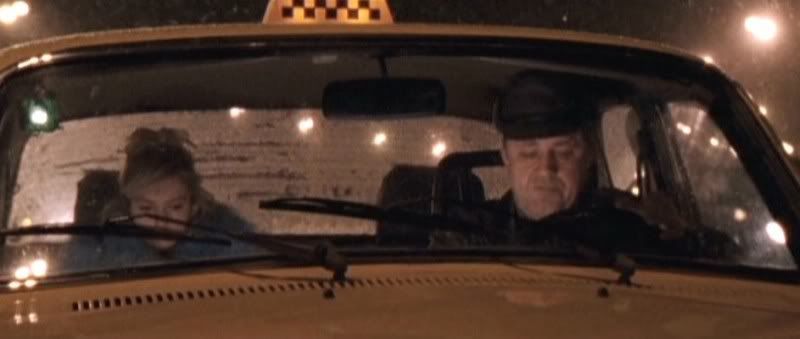
At the Cosmos Hotel, Yegor (receiving a hair cut from the girl vampire from the first film), tries to give Zavulon the Chalk. Gesser calls Zavulon and warns him that if Zavulon even touches the Chalk the Truce will be broken. Zavulon insists he wouldn't even think of it. Instead he has Yegor give the Chalk to Alisa. When asked what it is that she regrets she replies that it is the same thing all women regret, loving wrong. Events are building to a head. It is the night of Yegor's birthday/coming of age party. We see a murder of crows gather at the Cosmos Hotel, enter the lobby and fly through the hallways. This is the arrival of the party guests.
Alisa uses the Chalk to write the name "Kostya" on the wall, and immediately the young vampire shows up at her door. Kostya wants to take Alisa away, but she can't go with him because her ring binds her to Zavulon, and she's worried he'll kill Kostya. The Parrot manages to find Anton again, but Anton overpowers him. Anton then "steals" the Parrot's face by making an impression of it in the snow, picking it up and placing it over his own.
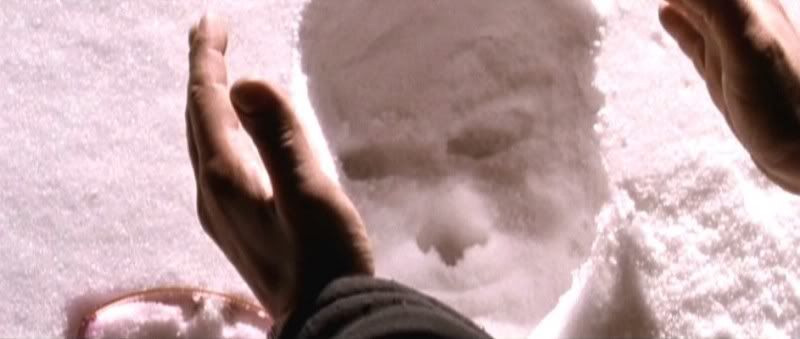
Using his disguise, Anton infiltrates the Cosmos Hotel, but his false face doesn't trick a Day Watch security guard. Anton escapes into the Gloom, leaving the mask behind. Through the Gloom he moves to the ball room, arriving just in time for Yegor's party.
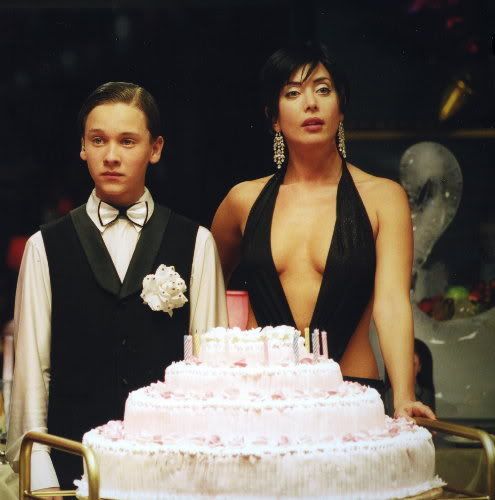
Note the Swan ice sculpture, yet another Bird of course, and a major Goddess emblem. To create the Dark Other party, director Bekmambetov had three hundred extras, including many real life Russian pop stars, politicians and artists, hold a real party, drinks and all, during which the footage with the principle players was filmed. Anton is greeted by Zavulon like a guest of honor. They clink glasses in a toast and a drop of Zavulon's wine taints Anton's vodka (reminiscent of the blood spiked initiatory drink Anton drank in "Night Watch" at Darya Schultz's). Anton is instantly and heavily intoxicated.
He then meets up with Darya Schultz, the Dark witch whose curse initiated Anton into the world of the Others, whom we learn has just been released from a twelve year punishment in the form of a toad for that crime. Anton spots Alisa with the Chalk, but states that even with it he could not change his Fate because the place where his destiny was broken, Darya Schultz's apartment, has been torn down. Schultz points out that the wall is still standing. Zavulon now has Anton in his grasp, but is waiting for another guest to arrive before he calls the Inquisition.
The guest Zavulon is awaiting is of course the Great Light Other Svetlana, the true target of Zavulon's complicated trap. She arrives and Anton tries to send her away. She mistakes Anton's intoxication for the regular variety and thinks maybe he has turned Dark. Due to the needle he implanted in her earlier, Yegor can still "drink" Svetlana, and he does so, quickly drawing the vitality out of her, reducing her to a shriveled crone-like state. The party is going full swing as this occurs, mixed amongst the dancing feet of the Dark Others we see goat legs. Olga calls Svetlana's cell and encourages her to keep going. Attesting to her great power, Svetlana fully recovers. Olga tells Svetlana to leave before it is too late. Svetlana tries to leave but she's stopped by Yegor, who is playing with a yo-yo/foil ball we saw Zavulon with earlier. Yegor tries to taunt Svetlana into a fight.
Meanwhile all of the Night Watch is rushing to the Cosmos Hotel. Zavulon reveals that he's looking to generate an excuse to end the Truce so that the War can break out and the Dark Others can tear the world apart. Trying to get away from him, Svetlana pushes Yegor and he falls and bloodies his nose. With blood spilled Zavulon considers the Truce violated and the War of Light and Darkness begins. As this film culminates in Ragnarok we can note that this conflict takes place at the Cosmos Hotel, cementing the astronomical/Age Shift connotations of mythological battles. Night Watch starts evacuating the normal humans. Yegor throws the foil ball and knocks Svetlana off her feet.

I was waiting for a good shot to point out Svetlana's blue feather coat. Yegor throws the ball again and this time it bursts open. A piece of the split foil falls on Svetlana's eyes, fusing them shut with silver metal.
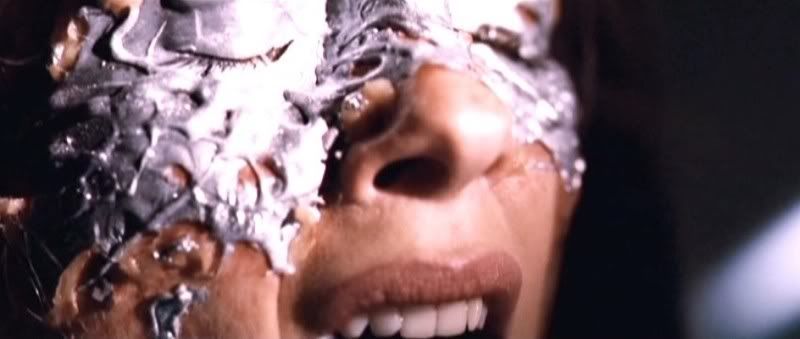
Further, the foil ball replicates, tripling itself, and then each of these again, and soon there are thousands of them hurtling at bullet velocity.
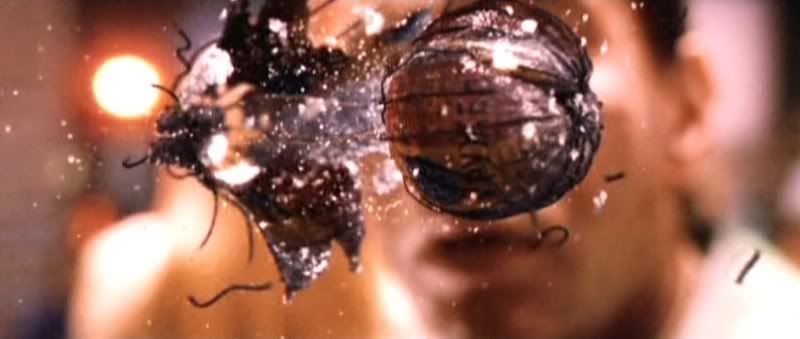
The foil balls fly through the walls of the hotel (and the people inside it) and rain into the city like a deadly hail storm or meteor shower. We see a Ferris Wheel (a Wheel of Fortune symbol) broken loose and sent rolling through the Moscow streets. Shortly thereafter the Ostankino Tower collapses (evoking the symbol of the Lightning Struck Tower, the collapse of the Axis Mundi, perfectly apt). It is an intriguing device, a child's play thing as the ultimate weapon of mass destruction. The Dark Others (those who weren't killed yet in the bombardment) continue dancing and partying. Zavulon calls it the End of the World. He sends one of his men to retrieve the Chalk of Fate from Alisa. Alisa, determined to get free from Zavulon, uses a knife to cut off her finger so she can finally remove his Ring.
Anton tries to find Alisa to get the Chalk. Night Watch arrives at the ball room and the party instantly turns into open warfare between sword wielding knights in armor, the reemergences of the War halted by the Truce at the beginning of the first film, as if the hundreds of years interim had never occurred. There is something surreal and ingenious to me about this interplay between raucous party and the War to end all Wars. Even as the ceiling and floor of the ball room give way in places the battle continues unabated.
With the assistance of a captured Little Masha (Schultz's familiar), Anton finds Alisa. He convinces her that all of this is ultimately his fault and that only he can rewrite things back to how they should be. She gives him the Chalk. As Anton tries to leave he's stopped by Svetlana and Yegor. They each grab one of his arms and try to pull him away from the other. As they do so the building and even the ground beneath them splits in two. A glass shard plummets from above directly at Anton's head. Just before it hits there is a flash of light and everything freezes in place.
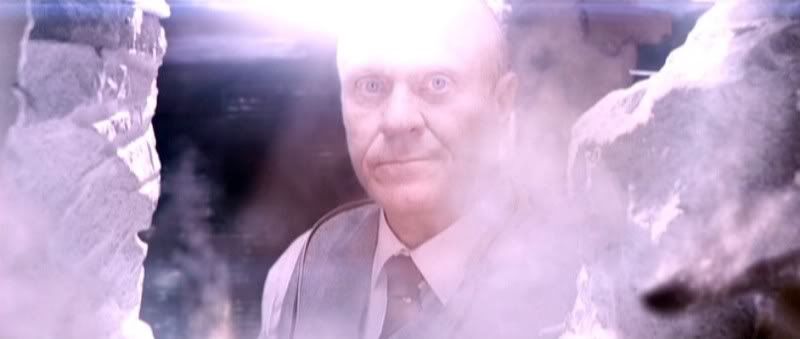
It is Gesser, using a magic camera with a flash that freezes time, buying Anton a chance to set things right. At nearly every instance the magical devices of the film are kept in a modern context, and we might note that a camera is a light emitting medium of artistic creation. Anton runs through the streets of Moscow. The city is as thoroughly devastated as it would be if struck by a nuclear bomb.
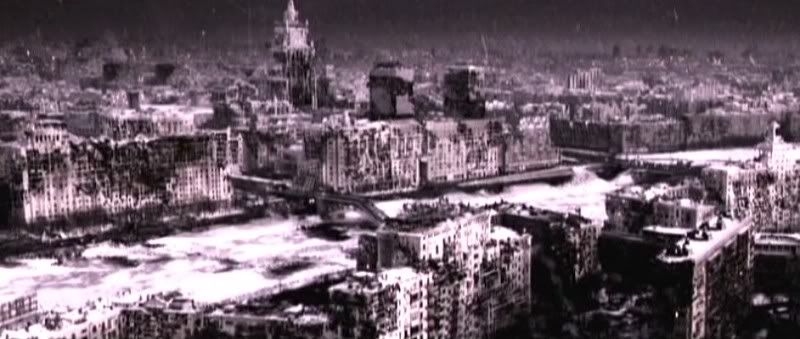
Anton reaches the still standing wall from where his destiny was broken, the wall he hit when he first entered the Gloom, the wall with the witch's collage.
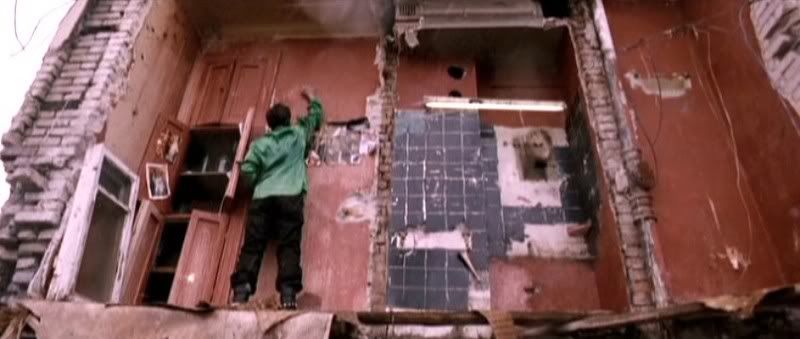
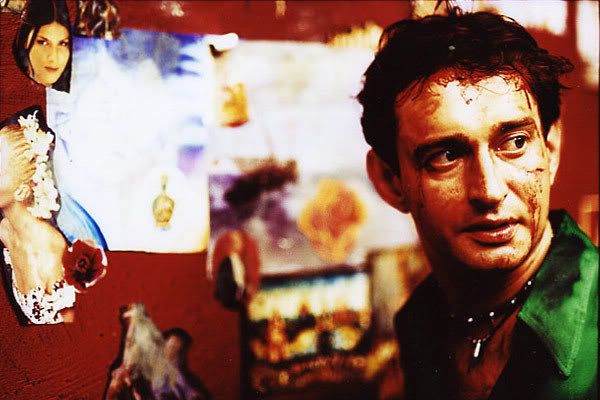
What does Anton write on this wall? And what happens after that? Well, you don't want me to tell you everything, do you? Actually there's quite a bit involved in this film that I skipped around or glossed over, you might have noticed, because I really only spoiled when necessary to describe the esoteric symbolic details of greatest interest to me. There is a great deal of complex, layered symbolism operating at many levels throughout these impeccably and (by American film standards) economically composed films, making them as interesting and perhaps as important as "The Matrix."
So, with the exception of course of "The Dark Knight", the Timur Bekmambetov movie "Wanted" has become the summer movie I most look forward to seeing (and both films feature Morgan Freeman, and Angelina Jolie plays a character named "Fox". Hmm...). Who knows, perhaps "Wanted" will turn out to be the secret third part of the Watch story. The premise, a man's initiation into a secret society of assassins/super-villains, is really not at all dissimilar. And note that "Wanted" is a second or even now third hand allusion to DC Comics' "Secret Society of Super Villains", the Secret Secret Secret Society of Super Villains. Batman Beware.
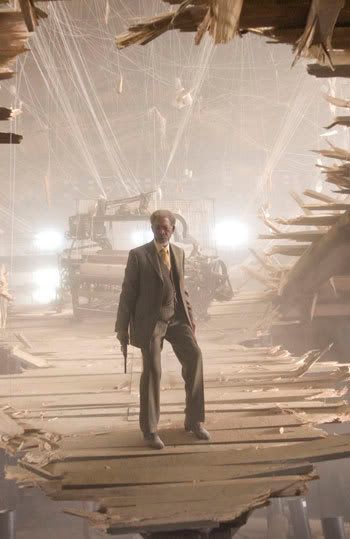
No comments:
Post a Comment